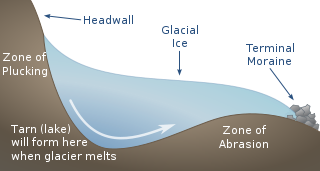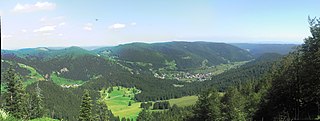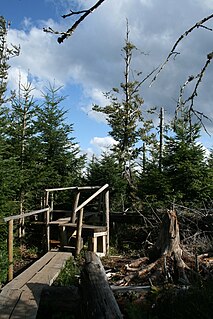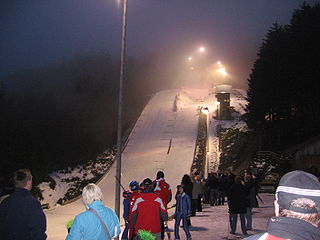| Buhlbachsee | |
|---|---|
 | |
| Location | Black Forest National Park, Baden-Württemberg, Germany |
| Coordinates | 48°30′03″N8°14′41″E / 48.500714°N 8.244606°E Coordinates: 48°30′03″N8°14′41″E / 48.500714°N 8.244606°E |
| Primary outflows | Buhlbach → Rechtmurg → Rhine → North Sea |
| Max. length | 0.20 km (0.12 mi) |
| Max. width | 0.16 km (0.099 mi) |
| Surface area | 1.2616 ha (3.117 acres) |
| Surface elevation | 785 m (2,575 ft) |
| Islands | An area of about 0.7 ha [1] |
The Buhlbachsee is a tarn (lake) in the northern Black Forest on the southwestern edge of the parish of Baiersbronn in the county of Freudenstadt in Baden-Württemberg. Since 1 January 2014 it has been part of the Black Forest National Park.

A tarn is a mountain lake, pond or pool, formed in a cirque excavated by a glacier. A moraine may form a natural dam below a tarn.

The Black Forest is a large forested mountain range in the state of Baden-Württemberg in southwest Germany. It is bounded by the Rhine valley to the west and south. Its highest peak is the Feldberg with an elevation of 1,493 metres (4,898 ft). The region is roughly oblong in shape with a length of 160 km (99 mi) and breadth of up to 50 km (31 mi).

Baiersbronn is a municipality in the district of Freudenstadt in Baden-Württemberg in southern Germany. It is situated in the Black Forest on the Murg river. Nearby is the mountain of Rinkenkopf with its hillfort, the Rinkenwall.

The tarn lies around 4.5 kilometres southeast of the summit of the Schliffkopf in the Buhlbach valley and less than half a kilometre northeast of the Black Forest High Road. The lake can be reached on foot over various paths including from Kniebis, Baiersbronn-Obertal or from the Black Forest High Road.

The Schliffkopf is a mountain in the Northern Black Forest between Baiersbronn, Ottenhöfen and Oppenau. It is 1,053.6 m above sea level (NHN). The Schliffkopf lies on the Black Forest High Road in the National Park and is the site of an epoymous four star "wellness" hotel. Various long distance paths, including the West Way, run over the Schliffkopf.

The Kniebis is a 960-metre-high mountain ridge in the Black Forest and the name of a village to the south which is a dispersed settlement. The Kniebis mountain rises in the state of Baden-Württemberg, Germany.
The tarn is about 160 metres wide and almost circular in shape. Only in the northeast, where the Buhlbach stream, which enters from the southwest, leaves the lake again is there a "nose" that gives it a length of about 200 metres. There is an island in the lake, about 0.7 hectares in area, which is covered in birch trees.

A birch is a thin-leaved deciduous hardwood tree of the genus Betula, in the family Betulaceae, which also includes alders, hazels, and hornbeams. It is closely related to the beech-oak family Fagaceae. The genus Betula contains 30 to 60 known taxa of which 11 are on the IUCN 2011 Green List of Threatened Species. They are a typically rather short-lived pioneer species widespread in the Northern Hemisphere, particularly in northern areas of temperate climates and in boreal climates.
Like all tarns the Buhlbachsee was formed by a glacier. After the last ice age, which ended in the Black Forest about 10,000 years ago, it was left behind.

A glacier is a persistent body of dense ice that is constantly moving under its own weight; it forms where the accumulation of snow exceeds its ablation over many years, often centuries. Glaciers slowly deform and flow due to stresses induced by their weight, creating crevasses, seracs, and other distinguishing features. They also abrade rock and debris from their substrate to create landforms such as cirques and moraines. Glaciers form only on land and are distinct from the much thinner sea ice and lake ice that form on the surface of bodies of water.

The Würm glaciation, in the literature usually just referred to as the Würm, often spelt "Wurm", was the last glacial period in the Alpine region. It is the youngest of the major glaciations of the region that extended beyond the Alps themselves. It is, like most of the other ice ages of the Pleistocene epoch, named after a river, the Würm in Bavaria, a tributary of the Amper. The Würm ice age can be dated to the time about 115,000 to 11,700 years ago, the sources differing depending on whether the long transition phases between the glacials and interglacials are allocated to one or other of these periods. The average annual temperatures during the Würm ice age in the Alpine Foreland were below −3 °C. This has been determined from changes in the vegetation as well as differences in the facies.















